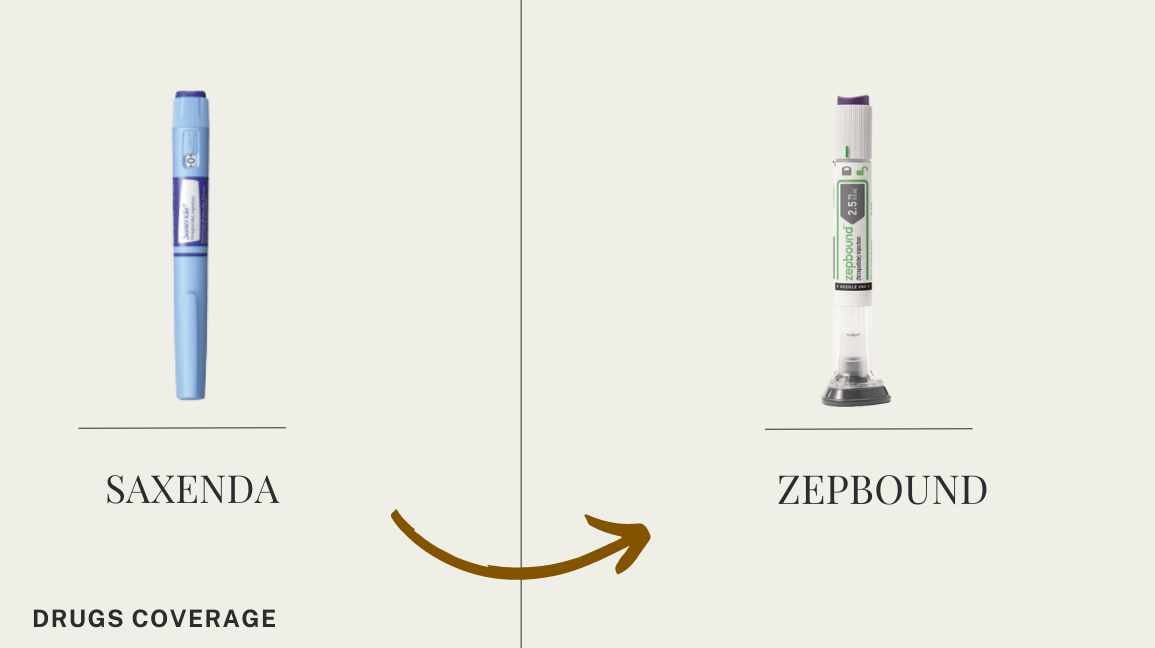
In the fast-changing world of treatments for weight loss, both patients and doctors are always looking for the best and safest options. The newest one getting noticed is Zepbound, a new medicine that says it’s better at helping with obesity and weight management than the older drug, Saxenda.
With more and more people getting obese around the world, Zepbound brings a bit of hope by being possibly more effective and having fewer bad effects.
This change is part of a bigger move towards doctors that focuses on the people, aiming to help with weight loss in a way that also makes the overall health of a person better.
But, if you’re one of the many people already using Saxenda to lose weight and want to switch to Zepbound, there are a few things you need to know.
What is Saxenda?
Saxenda is a weight loss drug that was approved by the FDA in 2014. It contains the active ingredient liraglutide, which acts like the GLP-1 hormone. This hormone is known to regulate appetite and food intake, which can cause weight loss.
Saxenda is usually prescribed for adults who have a body mass index (BMI) of 30 or higher, or those with a BMI of 27 or higher with at least one weight-related health condition such as high blood pressur, type 2 diabetes, or high cholesterol.
The drug is administered through a once-daily injection and should be used along with eating fewer calories and doing more exercise.
Side Effects
When using Saxenda, people might experience different side effects, from mild to serious. It’s important to know about these effects if you’re thinking about starting or switching to this medicine. Some of the most common side effects:
- Nausea
- Diarrhea
- Constipation
- Headache
- Vomiting
- Fatigue
- Dizziness
Other more serious side effects may include:
- Pancreatitis
- Gallbladder disease
- Hypoglycemia (low blood sugar)
- Increased heart rate
- Kidney problems
Introduction to Zepbound
Zepbound, an innovative treatment for obesity and weight management, was approved by the Food and Drug Administration (FDA) on November 8, 2023. This new development was a big challenge for Wegov by Novo Nordisk in the competitive world of weight loss drugs.
Administered through a weekly injection, Zepbound helps adults manage their weight. Its mechanism of action is particularly intriguing; Zepbound simulates the effects of two gut hormones critical in regulating food intake and insulin levels – glucagon-like peptide-1 (GLP-1) and glucose-dependent insulinotropic polypeptide (GIP).
GLP-1 helps you feel full and eat less, controlling how many calories you take in. GIP helps release insulin after you eat, helping manage your blood sugar levels.
Common Side Effects
When starting Zepbound, patients may encounter side effects, similar to those experienced with other weight management medications. Common side effects reported by users of Zepbound include:
- Digestive problems:
- Nausea
- Vomiting
- Diarrhea
- Constipation
- Abdominal pain
- Injection site reactions:
- Redness
- Swelling
- Itching
Can You Switch from Saxenda to Zepbound?

Yes, switching from Saxenda to Zepbound could be a good option for people wanting better ways to manage their weight. But, it’s important to talk to your doctor first because the two medicines are different.
Saxenda uses just one ingredient, liraglutide, to act like the GLP-1 hormone. But Zepbound uses liraglutide and another secret compound together to also target another hormone for managing weight.
Also, taking Saxenda needs a daily shot with changing doses, unlike Zepbound which is a once-a-week fixed dose. This means not just that Zepbound is easier to use, but it could also work better for losing weight, as studies show.
This stark difference in their composition, impact, and usage underscores the necessity of a guided transition, ensuring suitability and health safety.
Also Read: 7 Reasons You’re Not Losing Weight on Zepbound
Criteria for Eligibility to Switch
To be considered a candidate for switching from Saxenda to Zepbound, both patients and doctors must adhere to specific criteria that ensure the safety and efficacy of the transition. These criteria include, but are not limited to:
- BMI Requirements: Similar to Saxenda, candidates usually need to have a Body Mass Index (BMI) of 30 or higher, or a BMI of 27 or higher along with one weight-related condition such as hypertension, type 2 diabetes, or dyslipidemia.
- Tolerance to GLP-1 RAs: Since Zepbound functions partly by mimicking the GLP-1 hormone, patients should have a history of tolerating these types of medications without severe adverse effects.
- Commitment to Lifestyle Changes: An ongoing commitment to maintaining a healthy lifestyle, including diet and exercise, as Zepbound, like Saxenda, is meant to be used in conjunction with these modifications for optimal effectiveness.
- Monitoring Plan: Establishment of a follow-up and monitoring plan to assess the patient’s response to Zepbound, adjust dosages if necessary, and manage any potential side effects.
These eligibility criteria ensure that the switch from Saxenda to Zepbound is not only effective in aiding weight loss but also safe for the patient’s overall health.
Read more: Switching from Wegovy to Zepbound: A Patient’s Guide
How to Make the Switch
Making the switch from Saxenda to Zepbound involves a thoughtful approach under the guidance of healthcare professionals. If deemed suitable, the next steps include:
- Consultation: Discuss the potential benefits and risks of switching to Zepbound with your provider.
- Transition Plan: Your doctor will outline a transition plan, which may involve tapering off Saxenda before starting Zepbound to avoid overlapping effects or withdrawal symptoms.
- Prescription: If you meet the criteria for Zepbound, your doctor will provide you with a prescription and detailed instructions on dosage and administration.
- Follow-up: Regular follow-up appointments will be scheduled to monitor your progress, adjust the treatment as needed, and ensure the medication is effectively contributing to your weight management goals.
Possible Challenges During the Transition
Switching from Saxenda to Zepbound could come with its set of challenges, yet with proper medical guidance, these can be effectively managed.
- One issue is side effects. People used to Saxenda might know about feeling sick or having pain where they got their shot, but Zepbound has new ingredients, so there might be different side effects to watch out for.
- Also, getting the right dose might take some time. Saxenda lets you change the dose, but Zepbound has only one fixed dose. This means you might need a few doctor visits to get the dose just right for losing weight.
- Another thing to think about is insurance. Since Zepbound is new, insurance companies might not cover it the same way, which could make it more expensive for patients.
Finally, even though we hope Zepbound works better, it might not help with weight loss as much as Saxenda does. This shows why it’s so important to keep talking to doctors closely when trying something new.
Conclusion
In conclusion, moving from Saxenda to Zepbound is a positive step in weight management. Zepbound’s new approach of targeting two hormones could make losing weight easier and possibly work better for people having a hard time with it.
But, it’s important that this change is carefully watched by doctors, following certain rules and checking for any bad reactions. By focusing on what’s best for the patient, this new step can help people lose weight in a healthier, lasting way.
FAQ
Is Zepbound more effective than Saxenda?
Based on clinical trials, Zepbound has shown the potential to be more effective than Saxenda, with a significant portion of users experiencing over a 20% reduction in body weight. This means Zepbound could be a stronger option for people trying to manage their weight.
Why would someone want to switch from Saxenda to Zepbound?
People might switch from Saxenda to Zepbound for a few reasons. First, Zepbound is easier because you only take it once a week, unlike Saxenda, which needs a shot every day. Also, Zepbound works on two important weight control hormones, which might help people lose more weight. This two-way action might be better for those who didn’t get the results they wanted with just Saxenda.
Can Zepbound be used by everyone who takes Saxenda?
No, Zepbound cannot be used by everyone who takes Saxenda. Patients must meet specific criteria set by professionals, including BMI requirements, a history of tolerating GLP-1 receptor agonists, and a commitment to lifestyle changes. Additionally, the transition must be closely monitored to ensure it is safe and effective for the individual’s health needs.
Resources
- https://www.fda.gov/drugs/news-events-human-drugs/fda-approves-weight-management-drug-patients-aged-12-and-older
- https://www.fda.gov/news-events/press-announcements/fda-approves-new-medication-chronic-weight-management
- https://www.nbcnews.com/health/health-news/zepbound-eli-lilly-weight-loss-drug-what-to-know-rcna124237